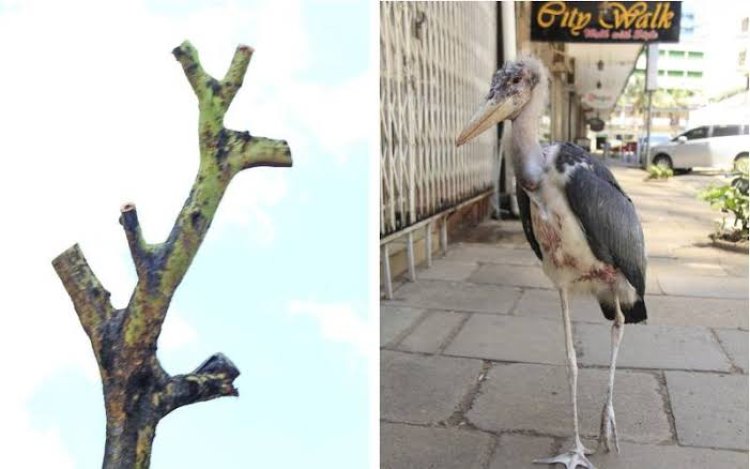Sakaja Explains Why Trees Are Being Pruned in Nairobi CBD
A photo had emerged of one of the trees along Kenyatta Avenue that appeared to be cut, raising concerns regarding the tree cover in the city.

Nairobi Governor, Johnson Sakaja has come clean on the ongoing exercise of pruning trees in the Nairobi Central Business District (CBD).
In a statement on Friday, September 23, Sakaja explained that many pedestrians had complained regarding the invasion of Marabou storks in the city, prompting the pruning exercise to take place.
"I have been assured that the pruning done after the outcry by pedestrians due to the recent Marabou stork’s invasion was procedural and that the tree shall be nurtured,” Sakaja stated.

A tree being pruned in Nairobi CBD on September 23, 2022. /MA3ROUTE
However, Sakaja was unhappy with how the pruning was being done, noting that more trees will be planted by his administration in the city.
A photo had emerged of one of the trees along Kenyatta Avenue that appeared to be cut, raising concerns regarding the tree cover in the city.
“I reiterate, we will increase our tree cover in the city. I was upset as you all but the tree will grow," he said.
Interesting Facts about Marabou Stork
The marabou stork is a large wading bird in the stork family. It breeds in Africa south of the Sahara, in both wet and arid habitats, often near human habitation, especially landfill sites.
It has been dubbed “the undertaker bird” because of its appearance. When seen from behind, the marabou stork’s back and wings appear cloak-like.
Its legs are skinny and white and sometimes there is a white tuft of what appears to be hair on its head.
As a carnivore, the marabou is a meat lover who feasts on the carcasses and scraps of dead animals. It often gathers around carcasses with vultures and hyenas and other warm-blooded animals.
Marabou storks are attracted to grass fires. They march in front of the advancing fire grabbing animals that are fleeing.
The Marabou stork has a long, reddish pouch hanging from its neck used in courtship rituals. It also connects directly to the left nostril and acts as a resonator allowing the bird to produce a guttural croaking.
While usually silent, the Marabou stork will also emit a sound caused by beak clacking if it feels threatened.

A marabou stork in Nairobi CBD. /STANDARD DIGITAL
Owing to the construction of the Nairobi Expressway, the birds were evicted from their usual shelter around Nyayo Stadium and relocated to dump sites as well as places they can nest. They sought shelter among the trees of Nairobi County.
Many trees along Mombasa Road were cut down during the Expressway's construction, forcing them to move to the Kenyatta International Convention Centre (KICC) in the middle of the CBD. However, the Nairobi County government cut their short stay by pruning the trees around.
Many residents also complained about the invasion of the storks due to the birds leaving droppings on cars parked in the city, coupled with a foul smell.






